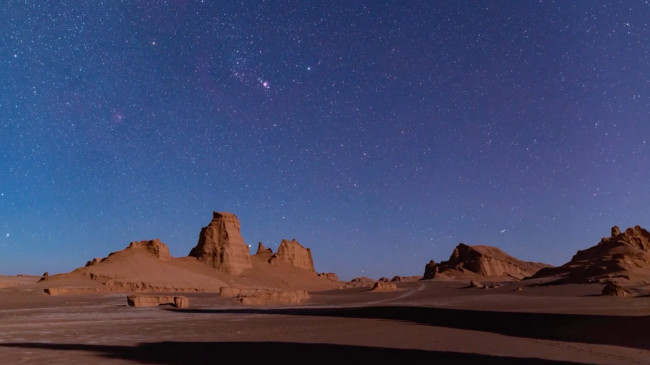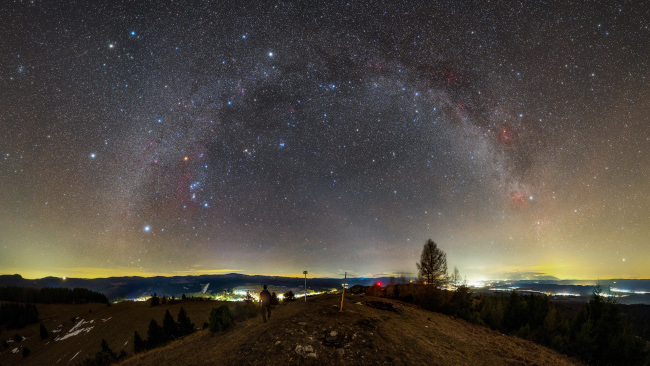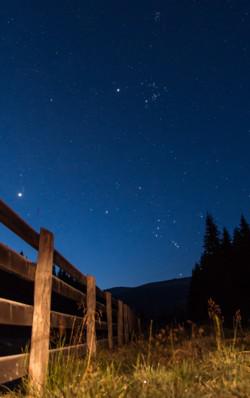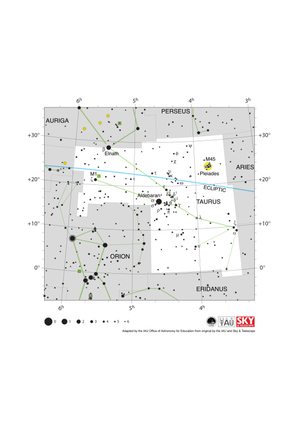Glossary term: 猎户座
Description: 猎户座是天赤道附近一个很容易辨认的星座。在北半球,它是一个显眼的冬季星座;在南半球,它是一个显眼的夏季星座。在希腊神话中,猎户座的形象被想象为一位猎人,该星座主要的几颗星通常被视作猎人的肩膀、腰带、腰带上悬挂的剑和两只脚。这些恒星大多是蓝巨星或蓝超巨星,也就是处于生命后期的特别明亮的偏蓝色恒星。猎人左肩的参宿四是一颗红超巨星,也就是处于生命最后阶段的非常明亮的红色恒星,它的红色在夜空中很容易看到。猎户座星云位于猎人的剑上,用肉眼看去,它是一团模糊的白色。天文望远镜显示,它是一团明亮的红色氢气云,目前那里正在诞生新的恒星。
Related Terms:
See this term in other languages
Term and definition status: The original definition of this term in English have been approved by a research astronomer and a teacher The translation of this term and its definition is still awaiting approval
The OAE Multilingual Glossary is a project of the IAU Office of Astronomy for Education (OAE) in collaboration with the IAU Office of Astronomy Outreach (OAO). The terms and definitions were chosen, written and reviewed by a collective effort from the OAE, the OAE Centers and Nodes, the OAE National Astronomy Education Coordinators (NAECs) and other volunteers. You can find a full list of credits here. All glossary terms and their definitions are released under a Creative Commons CC BY-4.0 license and should be credited to "IAU OAE".
If you notice a factual or translation error in this glossary term or definition then please get in touch.
Related Media
Constellations from the World
Credit: Stephanie Ye Ziyi/IAU OAE
License: CC-BY-4.0 Creative Commons 署名 4.0 国际 (CC BY 4.0) icons
智利的夜空
Credit: Robert Barsa/IAU OAE
License: CC-BY-4.0 Creative Commons 署名 4.0 国际 (CC BY 4.0) icons
猎户座在埃特纳火山上空升起
Credit: Dario Giannobile/IAU OAE
License: CC-BY-4.0 Creative Commons 署名 4.0 国际 (CC BY 4.0) icons
冬季星座
Credit: 阿米尔雷扎·卡姆卡尔/国际天文学联合会教育办公室
License: CC-BY-4.0 Creative Commons 署名 4.0 国际 (CC BY 4.0) icons
夜空中最亮的星
Credit: Giorgia Hofer/IAU OAE
License: CC-BY-4.0 Creative Commons 署名 4.0 国际 (CC BY 4.0) icons
Warm Winter Night Over Spiš Region
Credit: Robert Barsa/IAU OAE
License: CC-BY-4.0 Creative Commons 署名 4.0 国际 (CC BY 4.0) icons
Luminous Salar de Uyuni
Credit: Stephanie Ye Ziyi/IAU OAE
License: CC-BY-4.0 Creative Commons 署名 4.0 国际 (CC BY 4.0) icons
The Hunter in the Forest
Credit: René Antonio Urroz Álvarez/IAU OAE
License: CC-BY-4.0 Creative Commons 署名 4.0 国际 (CC BY 4.0) icons
Romanian Orion
Credit: Alex Conu/IAU OAE
License: CC-BY-4.0 Creative Commons 署名 4.0 国际 (CC BY 4.0) icons
Watchtower and Paddy Fields Under the Starry Sky
Credit: Likai Lin/IAU OAE
License: CC-BY-4.0 Creative Commons 署名 4.0 国际 (CC BY 4.0) icons
冬季星座
Credit: Mohamed Aboushelib/IAU OAE
License: CC-BY-4.0 Creative Commons 署名 4.0 国际 (CC BY 4.0) icons
The Kingdom of Orion
Credit: Carlos Zudaire/IAU OAE
License: CC-BY-4.0 Creative Commons 署名 4.0 国际 (CC BY 4.0) icons
Related Diagrams
猎户座星图
Credit: 由国际天文学联合会天文教育办公室根据国际天文学联合会/《天空与望远镜》的原文改编
License: CC-BY-4.0 Creative Commons 署名 4.0 国际 (CC BY 4.0) icons
Taurus Constellation Map
Credit: Adapted by the IAU Office of Astronomy for Education from the original by IAU/Sky & Telescope
License: CC-BY-4.0 Creative Commons 署名 4.0 国际 (CC BY 4.0) icons
Eridanus Constellation Map
Credit: Adapted by the IAU Office of Astronomy for Education from the original by the IAU and Sky & Telescope
License: CC-BY-4.0 Creative Commons 署名 4.0 国际 (CC BY 4.0) icons
Related Activities
Orion constellation in 3D
astroEDU educational activity (links to astroEDU website) Description: Let's make a simple model of the Orion constellationLicense: CC-BY-4.0 Creative Commons 署名 4.0 国际 (CC BY 4.0) icons
Age Ranges: 8-10 , 10-12 Education Level: Primary Areas of Learning: Guided-discovery learning , Modelling , Social Research Costs: Low Cost Duration: 2 hours Group Size: Group Skills: Analysing and interpreting data , Asking questions , Developing and using models























